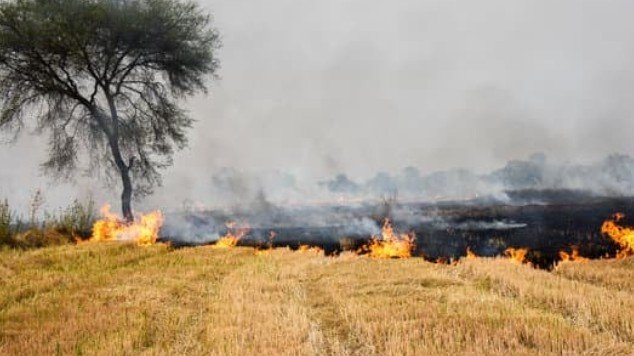Punjab recorded 104 fresh stubble-burning cases on November 14, pushing the season’s total to 4,838 incidents and intensifying concerns over deteriorating air quality in several districts. Even as the government accelerates enforcement measures and awareness campaigns, the latest data reveals that the crisis persists more strongly in agricultural belts like Fazilka, Mansa, and Bathinda, where paddy harvesting has just concluded. The rise has once again triggered ecological and administrative debate over the state’s struggle to curb residue burning despite subsidies, machinery distribution, and penalties.
The Air Quality Index (AQI) continues to fluctuate between the “poor” and “very poor” categories in multiple towns, revealing the direct impact of crop residue burning on the environment. With the winter inversion setting in, smoke tends to linger longer over the plains, creating smog layers that spread beyond Punjab’s borders into Haryana, Delhi, and NCR. Meteorological experts warn that even short-term spikes have cumulative effects, reducing visibility, exacerbating allergies, and increasing respiratory cases. Hospitals in Ludhiana, Patiala, and Jalandhar have already reported a rise in asthma, bronchial irritation, and breathlessness cases, especially among children and senior citizens.
Despite multiple interventions over the years, the issue persists due to economic and structural realities faced by farmers. Many cultivators argue that the narrow window between paddy harvest and wheat sowing leaves them with limited feasible alternatives. While the state has distributed thousands of crop management machines such as Happy Seeders, Super Seeders, and mulchers, the cost of operation, fuel consumption, and lack of operators discourage smaller farmers from opting for these technologies. The government’s efforts have improved compliance in some districts, but the overall situation remains challenging due to the sheer scale of Punjab’s paddy cultivation.
The state machinery has intensified monitoring through satellite imagery, field inspections, and rapid response teams. District administrations have been directed to take swift punitive action against erring farmers, but also to simultaneously offer alternatives and technical support. With over 7,000 nodal officers deployed at the village level, the government has been trying to strike a balance between enforcement and cooperation. However, agricultural unions argue that criminalizing farmers is not a sustainable solution and instead call for enhanced compensation and long-term crop diversification policies.
Fazilka, where stubble burning cases remain the highest this season, has been under particular scrutiny. Officials say that many fields in the area are operated by tenant farmers who often lack financial resources to adopt residue management technologies. Because they cultivate land on short-term leases, investing in machinery or labour-intensive alternatives becomes economically unviable. District officers have initiated community-led awareness drives and deployed teams to counsel farmers, but the results remain mixed.
Scientists and environmental experts are urging a shift away from paddy dependence, citing the crop’s heavy water footprint and its contribution to seasonal pollution. The Punjab Agricultural University and other research institutions have recommended encouraging farmers to adopt basmati varieties, maize, and other less water-intensive crops. The state’s announcement of incentives for direct seeding of rice (DSR) and diversification programs reflects this thinking, but the transition remains slow due to market limitations and procurement uncertainties.
Meanwhile, the National Green Tribunal and several environmental groups have urged stricter accountability, arguing that annual air pollution cycles pose long-term health and ecological dangers. Delhi, which experiences severe smog partly due to stubble burning, has also been pressing for coordinated North Indian action. Although Punjab has reduced stubble fires significantly compared to the peak years of 2016–2019, the problem persists enough to trigger recurring health alerts each winter.
As Punjab moves deeper into the residue burning season, officials remain hopeful that increasing awareness, coupled with real-time monitoring and community involvement, will help reduce incidents in the remaining weeks of November. However, the state acknowledges that only long-term agricultural reform — backed by financial support, market security, and technological accessibility — can deliver a permanent solution.




